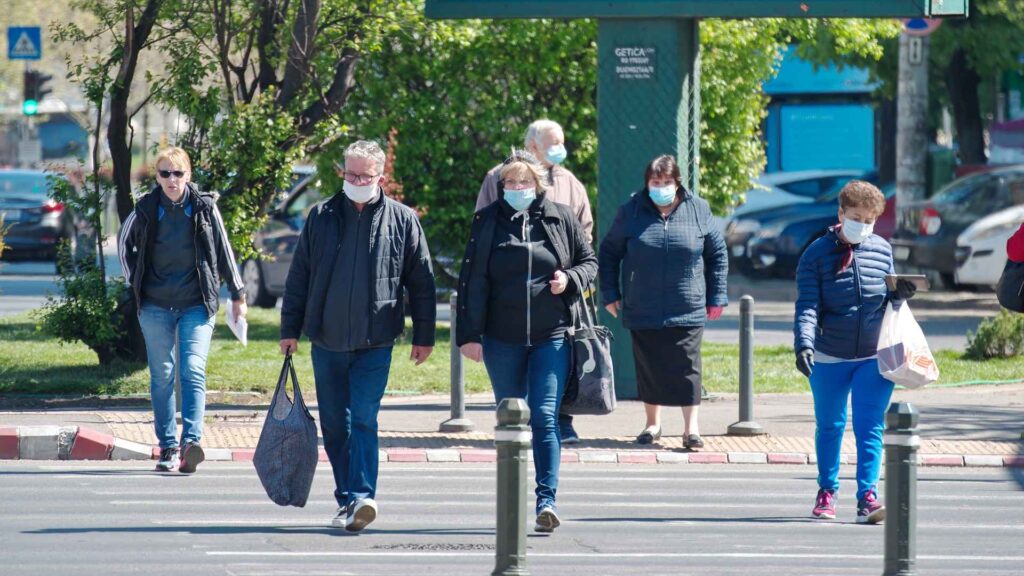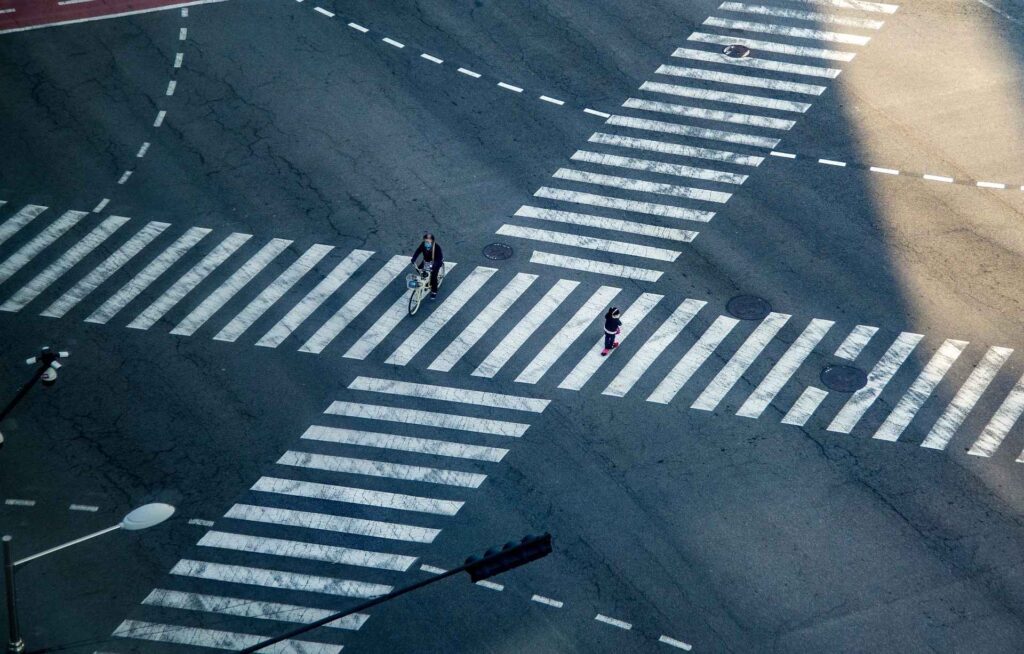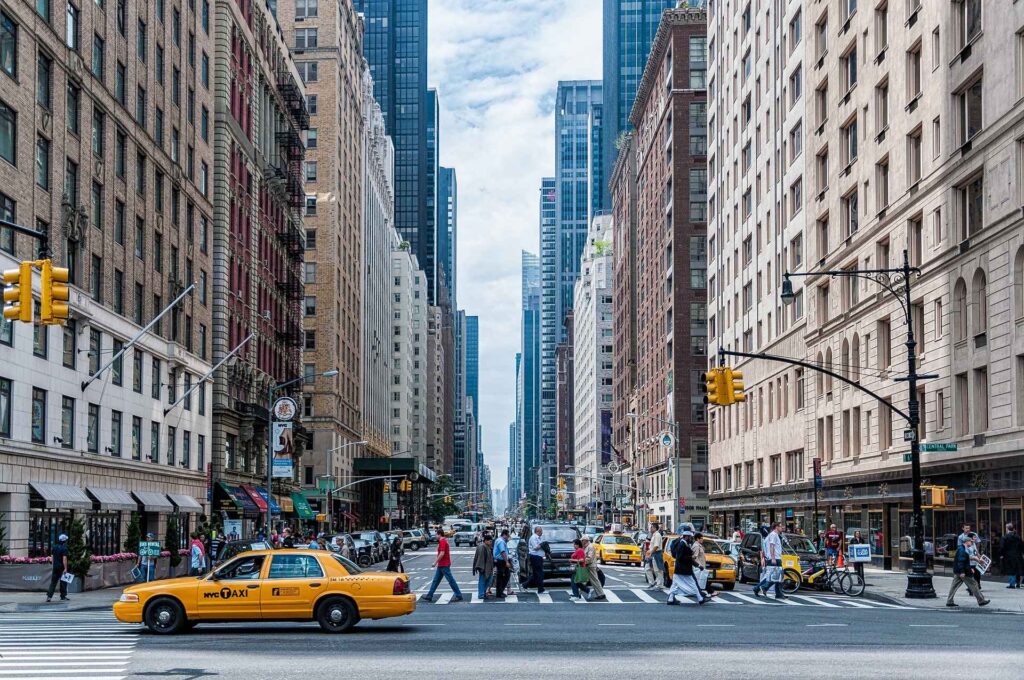Motorists and car occupants are not the only people at risk in car accidents. According to the NHTSA 2020 Traffic Safety Facts, crashes killed a pedestrian every 81 minutes on average in 2020. Pedestrian fatalities represent 17 percent of all traffic deaths in the same year. Meanwhile, 54,769 pedestrians sustained injuries in 2020, or two percent of all people harmed by motor vehicle accidents.
The legal definition of pedestrians is individuals traveling by foot and mobility-impaired persons in a wheelchair. However, the NHTSA data excludes those on roller and inline skates, motorized and non-motorized wheelchairs, scooters, etc.
Statistics from the CDC revealed alcohol impairment caused 46 percent of pedestrian fatalities in 2019. Approximately 32 percent of these traffic crashes involved pedestrians with an illegal level of blood alcohol concentration.
Most pedestrian fatalities happen in urban areas, on roadways far from intersections, and where speed limits are higher. Connect to a personal injury attorney if you or a loved one sustained serious injuries from a pedestrian accident. Law firms usually provide free consultations to evaluate
Key Takeaways
|
Types of Pedestrian-Car Accidents
Car accidents involving pedestrians don’t just happen on crosswalks. Accidents are more likely to happen when people walk along areas not specifically designed for pedestrians.
For instance, motorists expect pedestrians to be on the sidewalk and not on road shoulders. The sudden appearance of a pedestrian on the shoulder might trigger a motor vehicle accident. Below are common types of pedestrian-car accidents.
Crosswalk collisions
A crosswalk collision occurs at intersections when pedestrians cross paths with motorists. The problem is when the motorist fails to yield the right of way.
There are three instances where a motorist might hit a pedestrian at an intersection:
- When in front of a vehicle going straight.
- When in front of a car while it is turning right.
- When in front of a motorist who is turning left.
Drivers who make a left-hand or right-hand turn often put crossing pedestrians at risk. When turning, they focus more on other motorists getting into their lane. They may overlook people trying to cross the road.
“Multiple threat” accidents also occur on crosswalks. It happens when a driver stops to let a pedestrian cross the road. However, the driver in the next lane kept going because the stopped car blocked their view.
Sometimes, pedestrians also get “trapped” in crosswalks when the traffic signal changes before they finish crossing. When that happens, a motorist may drive through the intersection without realizing that a pedestrian is still on the crosswalk.
Parking lot accidents
This accident happens when motorists backing out or pulling into parking spots or driveways strike unsuspecting pedestrians.
It is especially true in parking lots where various vehicles and objects reduce visibility. In addition, drivers rushing to secure a prime parking area may overlook people walking around.
While new cars feature backup cameras, many still drive without one. In this case, a motorist might not be paying attention and fail to spot a pedestrian behind their car.
Sometimes, pedestrians may not notice a car’s reverse lights while walking past it. In any case, distracted walking and driving will always increase the chances of a pedestrian-car accident.
Hit-and-run accidents
The NHTSA’s 2020 Traffic Safety Facts also revealed that hit-and-run crashes caused approximately one in every four pedestrian fatalities. A hit-and-run is when a vehicle hits a pedestrian or another car and then leaves the scene of the accident.
For instance, an intoxicated driver traveling at night with a criminal record will likely leave the accident scene to avoid detention. With limited lighting and fewer witnesses, a drunk driver is most likely to get away.
Hit-and-run motorists may also leave the scene of the accident for other reasons. They may be an undocumented alien, drug-impaired, speeding, driving on a revoked or suspended license, etc. In some cases, they might have just panicked or were afraid of the legal consequences of their actions.
What’s worse is the driver at fault does not report the crash to local authorities or get help for the victims. Injured victims may receive medical attention too late.
However, it is not just cars that pose hazards to pedestrians. Motorcyclists or cyclists on trails and shared-use paths can hit people traveling on foot. It is why cyclists are legally prohibited from riding on sidewalks in some states.
The Leading Causes of Pedestrian Accidents
Driver error, vehicular issues, and environmental factors cause most car accidents in the US. Negligent drivers are often responsible for these accidents. However, distracted pedestrians may also be at fault for not paying adequate attention to traffic.
Distracted driving and texting are among the most common causes of pedestrian crashes. Motorists occupied with other activities will likely overlook pedestrians crossing the road or alighting from their cars.
Similarly, a person who walks into a crosswalk while texting is at higher risk of being involved in accidents. Texting pedestrians will most likely not notice traffic signals or traffic conditions on the road.
In general, pedestrians have the right-of-way in many situations. However, this rule does not apply to people who cross an intersection or roadway improperly.
Motorists may not have sufficient time to react and avoid jaywalking pedestrians. Likewise, people who attempt to use a crosswalk at the last second before the traffic light changes are prone to accidents.
Rain, snow, and fog also often reduce visibility on the road, making it more difficult for motorists to see pedestrians. Other factors that affect visibility include the following:
- Cars or objects on the roadside
- Pedestrians wearing dark-colored clothing at nighttime
- Weak headlights
When visibility is an issue, it is risky for pedestrians, especially children, to dart into the street without checking for oncoming traffic.
What To Do Immediately After a Pedestrian Crash


It is easy to feel confused and helpless following a pedestrian crash. The moments immediately after a car accident can be disorienting, especially for those who suffer severe injuries. But the actions of a motorist or pedestrian immediately after a pedestrian crash significantly affect their injury claim.
1. Stay on the scene
The most crucial thing to remember is never to leave the scene of the accident. Move off the road and check if all parties are safe from further injuries. Keep hazard lights on or set up flares to notify other drivers of an accident. Staying calm and looking for other possible hazards that may pose more risk to the parties involved is crucial.
2. Call the police
Call 911 and report the accident to local authorities. As much as possible, be precise when describing your surroundings so they can locate you quickly. Suppose law enforcement can’t come to the scene immediately. In that case, you may visit the nearest police station and file a report when you can.
3. Seek medical attention
Even if you only sustained minor injuries or generally feel well, it is still best to ask for medical attention from paramedics. Some crash injuries from car accidents are not apparent immediately. Symptoms may only appear a few days following the incident and may develop complications later.
4. Exchange information
Obtain the name and contact information of the other party. You may also ask for their
5. Gather evidence
Take photos of injuries you may have sustained, including cuts, scrapes, and bruises. You may also focus on the surrounding areas, like traffic signals or street signs. Remember to note the type, model, and color of their vehicle and their license plate number.
How To Start the Injury Claims Process
Before anything else, seek legal representation to have someone guide you throughout the filing. Personal injury lawyers know how to navigate legal processes to expedite your claim. It will ensure that you recover fair compensation the soonest.
A pedestrian accident attorney will assist you in tracking all the documentation needed for your claim. You need various reports and records on hand to process your
- Police report – This document details the characteristics of the accident. It consists of the law enforcement officer’s opinion on who is liable for the incident. In addition, it also bears a diagram of the accident scene, citations issued to the driver, and witness statements.
- Witness statements – A third party’s account of the accident is essential evidence for
insurance claims. You may also obtain these at the accident scene, along with their names and contact information. - Driver’s statements – You may always recall from memory, but the best approach is to record the driver’s statement. It is a vital element in proving fault and a piece of solid evidence to support your claim.
- Medical bills and records – If you sought medical attention immediately after the accident, your emergency room admissions chart can be vital evidence for your claim. In addition, medical bills prove your visits to the doctor and the cost of your injuries.
- Lost wages – You may ask your employer to provide a written report detailing the number of times you were unable to work. It includes vacation days or sick leaves you had to utilize for your recovery and the lost opportunity of overtime pay.
- Clothing – Keep and preserve the clothes you used during the crash. Your clothes, belt, shoes, purse, or backpack might help your claim. It could be convincing evidence if your clothes or bag were bloody, torn, or smudged with debris.
Who is liable for injuries or death of a pedestrian hit by a car?


Pedestrian-car accidents usually result in a disparity of damage. While the vehicle has little to no wear and its occupants are safe, the pedestrian suffers severe injuries. However, it doesn’t guarantee that liability will be easy to determine. Motorists and pedestrians have a duty of care when on public roads.
Driver
The driver or the vehicle’s owner involved in a car accident may be at fault for a pedestrian crash. Motorists are responsible for driving carefully and acting reasonably. It means they must travel at a safe speed and yield to pedestrians.
A driver may be liable for a car accident for the following reasons:
- Speeding through a residential neighborhood
- Driving impaired due to alcohol or drugs
- Failing to give a cyclist or pedestrian the right of way
- Failing to recognize a marked crosswalk not located at an intersection
- Overlooking children playing on the street
- Failing to stop for a pedestrian using a crosswalk at an intersection
Pedestrian
Motorists are often liable when a pedestrian is hit by a car. But in some cases, pedestrians can share liability with a motorist for a motor vehicle accident.
A pedestrian’s negligent acts might result in legal consequences if they cause a pedestrian-car accident. These include the following scenarios:
- When they cross a street without using a crosswalk (jaywalking)
- When they don’t obey a road sign or a traffic signal
- When they walk along a road where pedestrians are not allowed
- Whey they dart in front of a car without providing a motorist enough time to stop completely
Government
Section 116 of the US Code mandates that a state’s transportation department should perform preventive maintenance on all public roadways. It includes pavement preservation programs and activities, defined as:
“Programs and activities employing a network level, long-term strategy that enhances pavement performance by using an integrated, cost-effective set of practices that extend pavement life, improve safety, and meet road user expectations.”
The federal or state government agency that fails to perform such duties shall be liable for accidents on public roads. These include not repairing a broken traffic light, not placing a relevant traffic sign, or designing a crosswalk poorly.
Contributory Negligence Rules in Pedestrian-Car Accident Cases
A pedestrian may be subject to contributory negligence rules if they are partly liable for a motor vehicle accident. Depending on your state, one of three rules may apply to your
Contributory negligence bars an injured victim from recovering damages if the court finds them at least one percent liable for the accident. However, this rule only applies to four states: Alabama, North Carolina, Maryland, and Virginia.
Pure comparative negligence divides compensation according to the parties’ percentage of fault. For instance, if the court finds a pedestrian 60 percent liable for the accident, they may recover 40 percent of their losses.
Modified comparative negligence likewise splits damages up to a certain percentage. A pedestrian may still recover damages proportionate to their fault. However, if the court determines their fault is more than 50 or 51 percent, they are prohibited from receiving damages.
Liability Car Insurance vs. No-Fault Insurance
Liability car
On the other hand, other laws apply if you reside in a state with no-fault
Usually, no-fault states require their residents to carry personal injury protection (PIP) coverage. It covers the policyholder’s and their passenger’s medical expenses related to the motor vehicle accident.


Pro Tip
All intersections meeting at right angles legally include crosswalks, marked or unmarked. Pedestrians can cross intersections with unmarked crosswalks and retain the same protections as those who use marked ones. For instance, victims may recover damages through an injury claim after an accident.
Connect With a Personal Injury Lawyer
If you sustained injuries in a negligent pedestrian-car accident, seek legal advice from a personal injury lawyer. They have experience processing claims to help victims seek damages for injury claims.
The Personal Injury Center has the resources and knowledge necessary to aid injured pedestrians in recovering fair and immediate compensation. If you have concerns about your case, check out our comprehensive database of legal articles. They will help you understand your legal options before committing to a pedestrian accident lawyer.
Let a pedestrian accident lawyer help with your injury claim. Visit The Personal Injury Center to find a lawyer for your case.
FAQs on Pedestrian Hit by a Car
What common injuries do pedestrians sustain after a car accident?
Pedestrians might suffer severe injuries in motor vehicle accidents. It includes soft tissue damage, broken bones, traumatic brain injuries, and spinal cord injuries.
What factors determine the value of my insurance claim?
Multiple factors influence the value of your pedestrian injury claim. The most crucial factor is the nature and severity of your injuries. In addition, the steps you take after the accident also contribute to your case, such as how soon you sought medical attention.
The amount of the plaintiff's insurance coverage may also limit how much you may recover. If your losses exceed the insurance coverage, you may seek additional compensation by suing the at-fault driver. However, the percentage of your liability affects the amount of damages you may recover from the other party.
Can I file an insurance claim against a motorist who ran over my foot?
No matter how minor the injuries are, the best approach is to file an insurance claim. The case will be credible if you can prove fault and damage.
Asking for legal advice in an injury case such as this will make the process easier. A personal injury lawyer will inform you of your rights and the possible legal options you may take.



